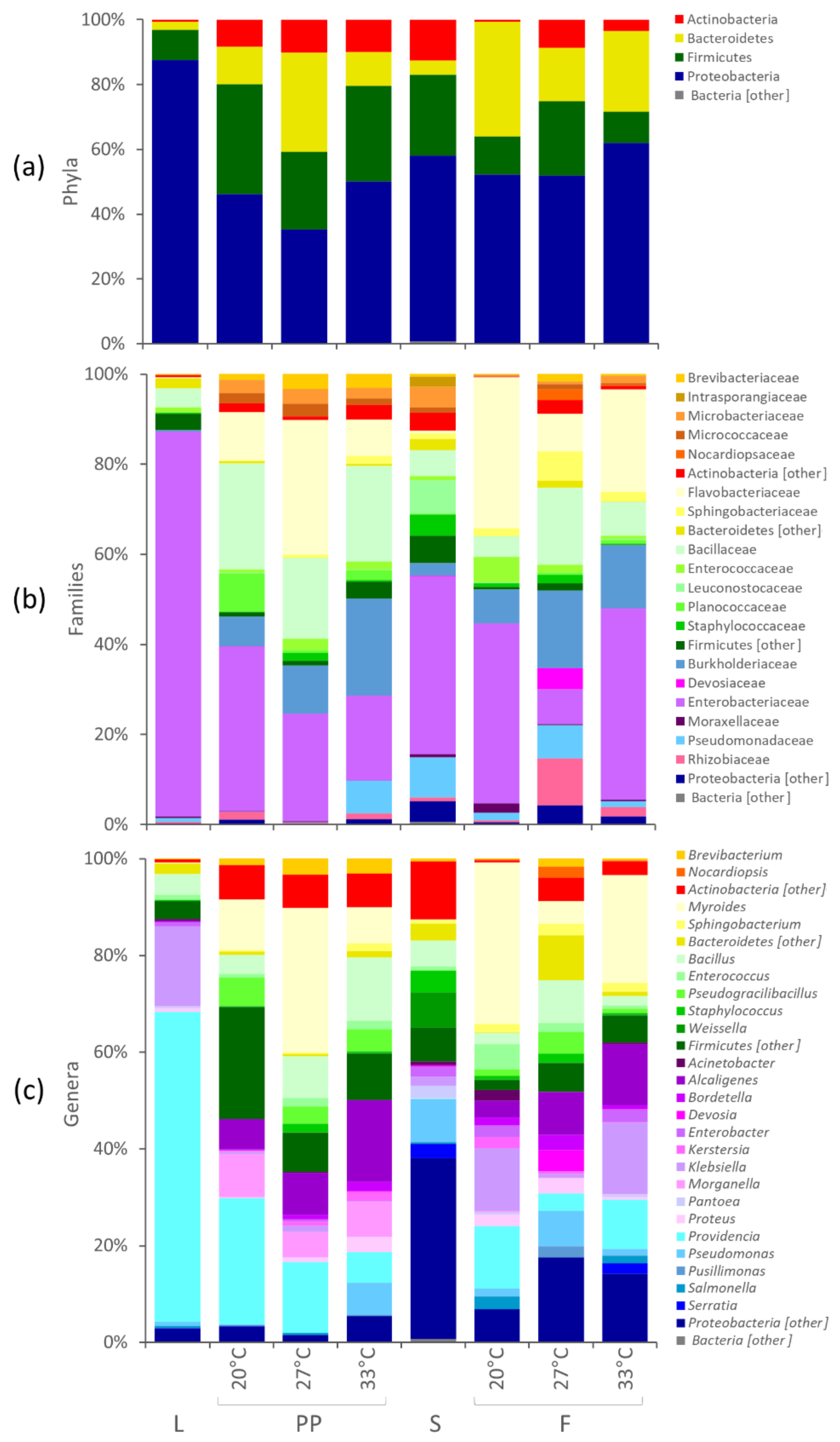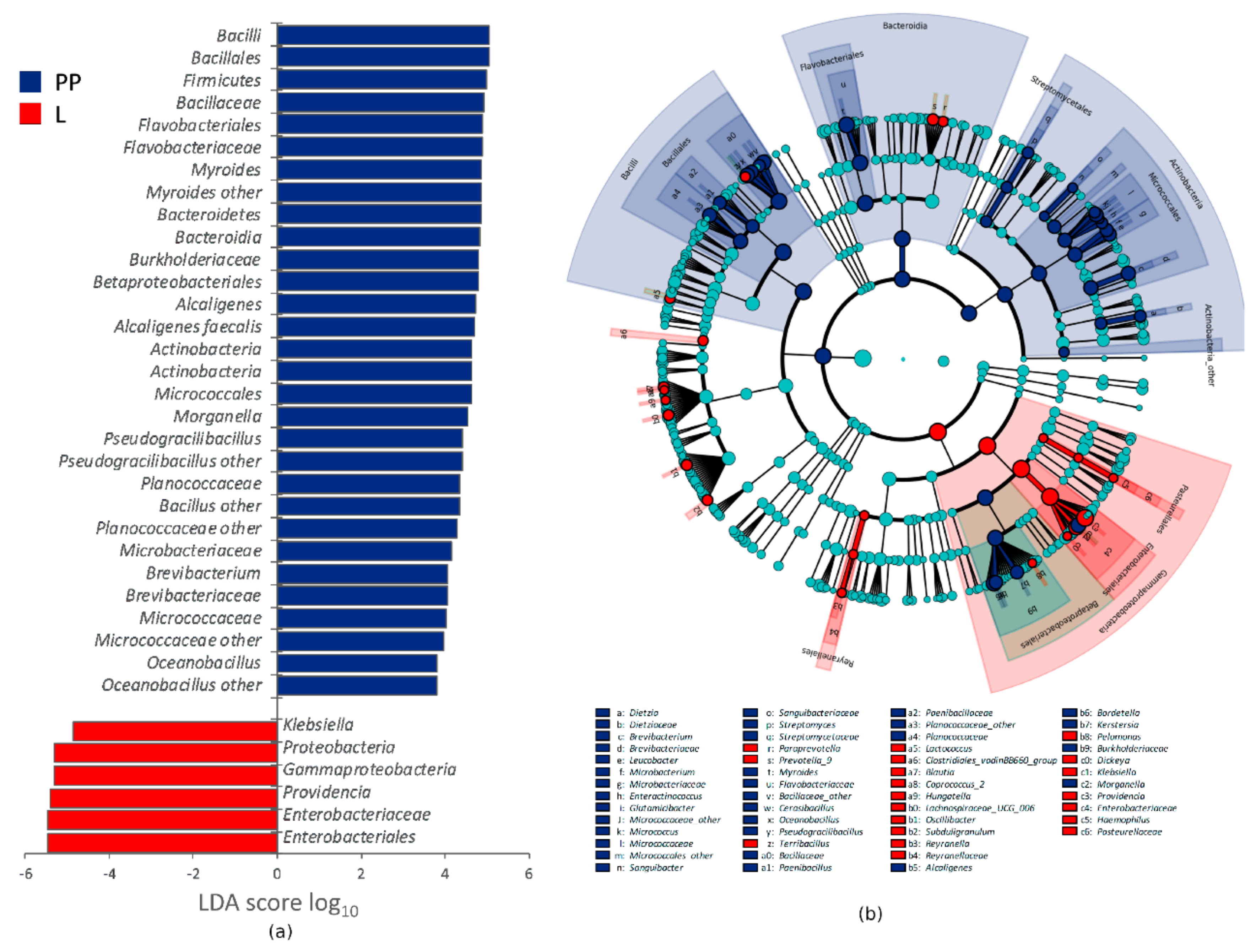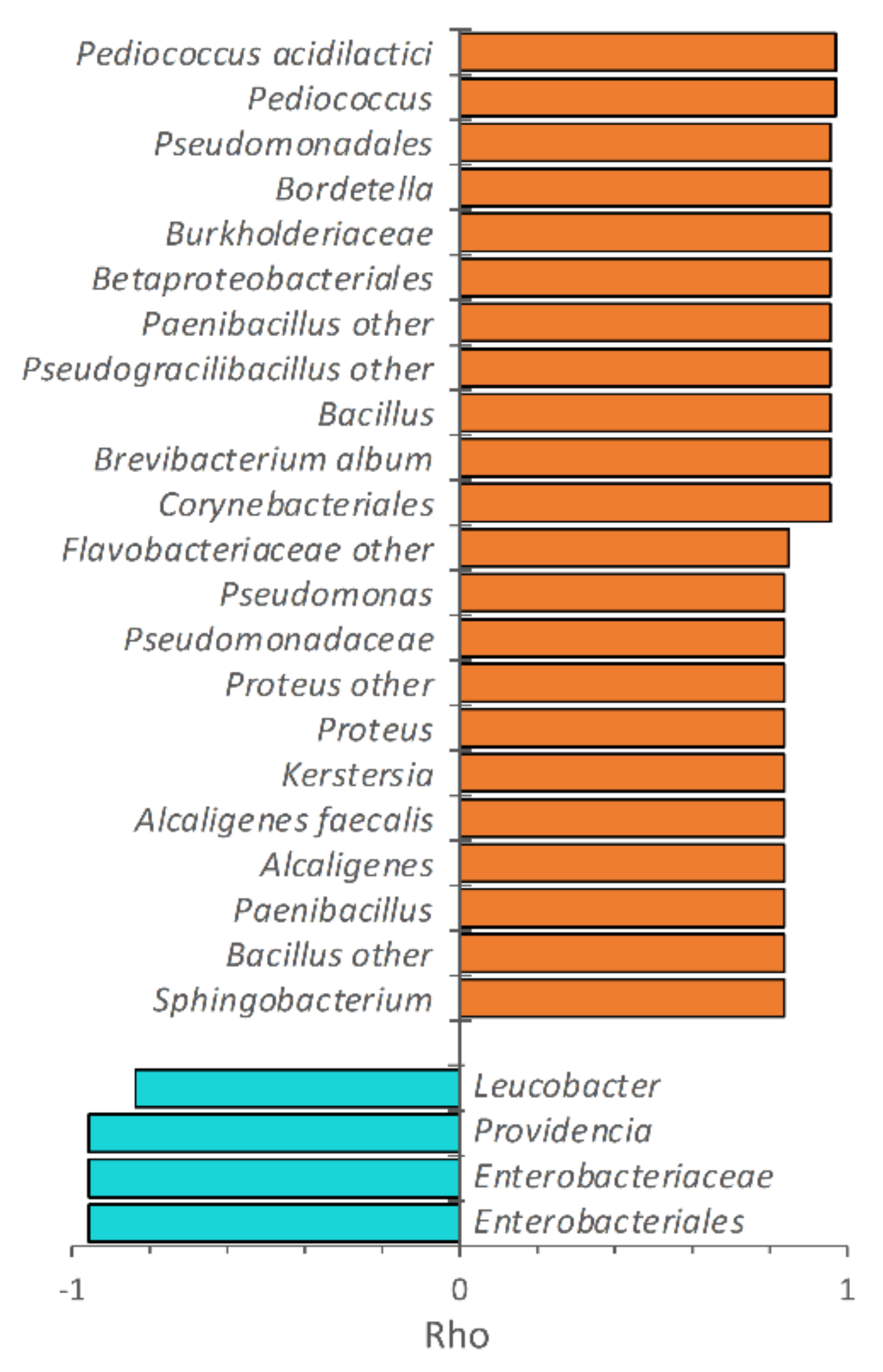Effect of Rearing Temperature on Growth and Microbiota Composition of Hermetia illucens
Abstract
1. Introduction
2. Materials and Methods
2.1. Hermetia illucens Rearing
2.2. Culture Dependent Microbiological Analyses
2.3. 16S rRNA Gene Profiling
2.4. Statistics
3. Results
3.1. Growth Performance of Hermetia illucens at Different Temperatures
3.2. Culture Dependent Microbiological Analysis
3.3. Microbiota Composition by Metagenome Analysis
4. Discussion
Supplementary Materials
Author Contributions
Funding
Conflicts of Interest
References
- Wang, Y.S.; Shelomi, M. Review of Black Soldier Fly (Hermetia illucens) as Animal Feed and Human Food. Foods 2017, 6, 91. [Google Scholar] [CrossRef]
- Cutrignelli, M.I.; Messina, M.; Tulli, F.; Randazzo, B.; Olivotto, I.; Gasco, L.; Loponte, R.; Bovera, F. Evaluation of an insect meal of the Black Soldier Fly (Hermetia illucens) as soybean substitute: Intestinal morphometry, enzymatic and microbial activity in laying hens. Res. Vet. Sci. 2018, 117, 209–215. [Google Scholar] [CrossRef]
- Terova, G.; Rimoldi, S.; Ascione, C.; Gini, E.; Ceccotti, C.; Gasco, L. Rainbow trout (Oncorhynchus mykiss) gut microbiota is modulated by insect meal from Hermetia illucens prepupae in the diet. Rev. Fish Biol. Fisher. 2019, 29, 465–486. [Google Scholar] [CrossRef]
- Belghit, I.; Liland, N.S.; Gjesdal, P.; Biancarosa, I.; Menchetti, E.; Li, Y.; Waagbø, R.; Krogdahl, Å.; Lock, E.J. Black soldier fly larvae meal can replace fish meal in diets of sea-water phase Atlantic salmon (Salmo salar). Aquaculture 2019, 503, 609–619. [Google Scholar] [CrossRef]
- Zarantoniello, M.; Randazzo, B.; Truzzi, C.; Giorgini, E.; Marcellucci, C.; Vargas-Abúndez, J.A.; Zimbelli, A.; Annibaldi, A.; Parisi, G.; Tulli, F.; et al. A six-months study on Black Soldier Fly (Hermetia illucens) based diets in zebrafish. Sci. Rep. 2019, 9, 8598. [Google Scholar] [CrossRef] [PubMed]
- Truzzi, C.; Giorgini, E.; Annibaldi, A.; Antonucci, M.; Illuminati, S.; Scarponi, G.; Riolo, P.; Isidoro, N.; Conti, C.; Zarantoniello, M.; et al. Fatty acids profile of black soldier fly (Hermetia illucens): Influence of feeding substrate based on coffee-waste silverskin enriched with microalgae. Anim. Feed Sci. Technol. 2020, 259, 114309. [Google Scholar] [CrossRef]
- Bruni, L.; Pastorelli, R.; Viti, C.; Gasco, L.; Parisi, G. Characterisation of the intestinal microbial communities of rainbow trout (Oncorhynchus mykiss) fed with Hermetia illucens (black soldier fly) partially defatted larva meal as partial dietary protein source. Aquaculture 2018, 487, 56–63. [Google Scholar] [CrossRef]
- Barragan-Fonseca, K.B.; Dicke, M.; van Loon, J.J.A. Nutritional value of the black soldier fly (Hermetia illucens L.) and its suitability as animal feed—A review. J. Ins. Food Feed. 2017, 3, 105–120. [Google Scholar] [CrossRef]
- Lalander, C.H.; Fidjeland, J.; Diener, S.; Eriksson, S.; Vinnerås, B. High waste-to-biomass conversion and efficient Salmonella spp. reduction using black soldier fly for waste recycling. Agron. Sust. Dev. 2015, 35, 261–271. [Google Scholar] [CrossRef]
- Nguyen, T.T.; Tomberlin, J.K.; Vanlaerhoven, S. Ability of Black Soldier Fly (Diptera: Stratiomyidae) Larvae to Recycle Food Waste. Environ. Entomol. 2015, 44, 406–410. [Google Scholar] [CrossRef]
- Bortolini, S.; Macavei, L.I.; Hadj Saadoun, J.; Foca, G.; Ulrici, A.; Bernini, F.; Malferrari, D.; Setti, L.; Ronga, D.; Maistrello, L. Hermetia illucens (L.) larvae as chicken manure management tool for circular economy. J. Clean. Prod. 2020, 262, 121289. [Google Scholar] [CrossRef]
- EFSA Scientific Committee. Risk profile related to production and consumption of insects as food and feed. EFSA J. 2015, 13, 4257. [Google Scholar] [CrossRef]
- De Smet, J.; Wynants, E.; Cos, P.; Van Campenhout, L. Microbial community dynamics during rearing of black soldier fly larvae (Hermetia illucens) and impact on exploitation potential. Appl. Environ. Microbiol. 2018, 84, e02722-17. [Google Scholar] [CrossRef] [PubMed]
- Osimani, A.; Milanović, V.; Garofalo, C.; Cardinali, F.; Roncolini, A.; Sabbatini, R.; De Filippis, F.; Ercolini, D.; Gabucci, C.; Petruzzelli, A.; et al. Revealing the microbiota of marketed edible insects through PCR-DGGE, metagenomic sequencing and real-time PCR. Int. J. Food Microbiol. 2018, 276, 54–62. [Google Scholar] [CrossRef]
- Wynants, E.; Frooninckx, L.; Crauwels, S.; Verreth, C.; De Smet, J.; Sandrock, C.; Wohlfahrt, J.; Van Schelt, J.; Depraetere, S.; Lievens, B.; et al. Assessing the microbiota of black soldier fly larvae (Hermetia illucens) reared on organic waste streams on four different locations at laboratory and large scale. Microbial. Ecol. 2018, 77, 913–930. [Google Scholar] [CrossRef]
- Bruno, D.; Bonelli, M.; De Filippis, F.; Di Lelio, I.; Tettamanti, G.; Casartelli, M.; Ercolini, D.; Caccia, S. The Intestinal Microbiota of Hermetia illucens Larvae Is Affected by Diet and Shows a Diverse Composition in the Different Midgut Regions. Appl. Environ. Microbiol. 2019, 85, e01864-18. [Google Scholar] [CrossRef]
- Jeon, H.; Park, S.; Choi, J.; Jeong, G.; Lee, S.B.; Choi, Y.; Lee, S.J. The intestinal bacterial community in the food waste-reducing larvae of Hermetia illucens. Curr. Microbiol. 2011, 62, 1390–1399. [Google Scholar] [CrossRef]
- Zheng, L.; Crippen, T.L.; Singh, B.; Tarone, A.M.; Dowd, S.; Yu, Z.; Wood, T.K.; Tomberlin, J.K. A survey of bacterial diversity from successive life stages of black soldier fly (Diptera: Stratiomyidae) by using 16S rDNA pyrosequencing. J. Med. Entomol. 2013, 50, 647–658. [Google Scholar] [CrossRef]
- NVWA. Advisory Report on the Risks Associated with the Consumption of Mass-Reared Insects; NVWA/BuRO/2014/2372; Netherlands Food and Consumer Product Safety Authority: Utrecht, The Netherlands, 2014. [Google Scholar] [CrossRef]
- NVWA. Advice on Animal and Public Health Risks of Insects Reared on Former Foodstuffs as Raw Material for Animal Feed; TRCNVWA/2019/6200/EN; Netherlands Food and Consumer Product Safety Authority: Utrecht, The Netherlands, 2019. [Google Scholar]
- Grabowski, N.T.; Klein, G. Microbiology of processed edible insect products—Results of a preliminary survey. Int. J. Food Microbiol. 2017, 243, 103–107. [Google Scholar] [CrossRef]
- Hogsette, J.A. New diets for production of house-flies and stable flies (Diptera, Muscidae) in the laboratory. J. Econ. Entomol. 1992, 85, 2291–2294. [Google Scholar] [CrossRef]
- ISO. Microbiology of Food and Animal Feeding Stuffs—Horizontal Method for the Enumeration of Presumptive Bacillus Cereus—Colony-Count Technique at 30 Degrees C; ISO 7932:2004; International Organization for Standardization: Geneva, Switzerland, 2004. [Google Scholar]
- ISO. Microbiology of Food and Animal Feeding Stuffs—Horizontal Method for the Enumeration of Clostridium perfringens—Colony-Count Technique; ISO 7937:2004; International Organization for Standardization: Geneva, Switzerland, 2004. [Google Scholar]
- ISO. Microbiology of Food and Animal Feed—Horizontal Method for the Detection, Enumeration and Serotyping of Salmonella—Part 2: Enumeration by a Miniaturized Most Probable Number Technique; ISO/TS 6579-2:2012; International Organization for Standardization: Geneva, Switzerland, 2012. [Google Scholar]
- ISO. Microbiology of the Food Chain—Horizontal Method for Detection and Enumeration of Campylobacter spp.—Part 2: Colony-Count Technique; ISO 10272-2:2017; International Organization for Standardization: Geneva, Switzerland, 2017. [Google Scholar]
- ISO. Microbiology of the Food Chain—Horizontal Method for the Detection and Enumeration of Listeria monocytogenes and of Listeria spp.—Part 2: Enumeration Method; ISO 11290-2:2017; International Organization for Standardization: Geneva, Switzerland, 2017. [Google Scholar]
- ISO. Microbiology of the Food Chain—Horizontal Method for the Detection, Enumeration and Serotyping of Salmonella—Part 1: Detection of Salmonella spp.; ISO 6579-1:2017; International Organization for Standardization: Geneva, Switzerland, 2017. [Google Scholar]
- ISO. Microbiology of Food and Animal Feeding Stuffs—Horizontal Method for the Enumeration of Coagulase-Positive Staphylococci (Staphylococcus aureus and other species)—Part 1: Technique Using Baird-Parker Agar Medium; ISO 6888-1:1999/AMD 2:2018; International Organization for Standardization: Geneva, Switzerland, 2018. [Google Scholar]
- Milani, C.; Hevia, A.; Foroni, E.; Duranti, S.; Turroni, F.; Lugli, G.A.; Sanchez, B.; Martín, R.; Gueimonde, M.; van Sinderen, D.; et al. Assessing the fecal microbiota: An optimized ion torrent 16S rRNA gene-based analysis protocol. PLoS ONE 2013, 8, e68739. [Google Scholar] [CrossRef]
- Schloss, P.D.; Westcott, S.L.; Ryabin, T.; Hall, J.R.; Hartmann, M.; Hollister, E.B.; Lesniewski, R.A.; Oakley, B.B.; Parks, D.H.; Robinson, C.J.; et al. Introducing mothur: Open-source, platform-independent, community-supported software for describing and comparing microbial communities. Appl. Environ. Microbiol. 2009, 75, 7537–7541. [Google Scholar] [CrossRef]
- Bokulich, N.A.; Kaehler, B.D.; Rideout, J.R.; Dillon, M.; Bolyen, E.; Knight, R.; Huttley, G.A.; Caporaso, J.G. Optimizing taxonomic classification of marker-gene amplicon sequences with QIIME 2’s q2-feature-classifier plugin. Microbiome 2018, 6, 90. [Google Scholar] [CrossRef] [PubMed]
- Bolyen, E.; Rideout, J.R.; Chase, J.; Pitman, T.A.; Shiffer, A.; Mercurio, W.; Dillon, M.R.; Caporaso, J.G. An introduction to applied bioinformatics: A free, open, and interactive text. J. Open Source Educ. 2018, 1, 27. [Google Scholar] [CrossRef] [PubMed]
- Segata, N.; Izard, J.; Waldron, L.; Gevers, D.; Miropolsky, L.; Garrett, W.S.; Huttenhower, C. Metagenomic biomarker discovery and explanation. Genome Biol. 2011, 12, R60. [Google Scholar] [CrossRef] [PubMed]
- Tomberlin, J.K.; Sheppard, D.C. Lekking behavior of the black soldier fly (Diptera: Stratiomyidae). Fla. Entomol. 2001, 84, 729–730. [Google Scholar] [CrossRef]
- Park, K.H.; Kim, W.T.; Lee, S.B.; Choi, Y.C.; Nho, S.K. Seasonal Pupation, Adult Emergence and Mating of Black Soldier Fly, Hermetia illucens (Diptera: Stratiomyidae) in Artificial Rearing System. Int. J. Ind. Entomol. 2010, 21, 189–191. [Google Scholar]
- Gligorescu, A.; Toft, S.; Hauggaard-Nielsen, H.; Axelsen, J.A.; Nielsen, S.A. Development, metabolism and nutrient composition of black soldier fly larvae (Hermetia illucens; Diptera: Stratiomyidae) in relation to temperature and diet. J. Insects Food Feed 2018, 4, 123–133. [Google Scholar] [CrossRef]
- Harnden, L.M.; Tomberlin, J.K. Effects of temperature and diet on black soldier fly, Hermetia illucens (L.) (Diptera: Stratiomyidae), development. Forensic Sci. Int. 2016, 266, 109–116. [Google Scholar] [CrossRef]
- Tomberlin, J.K.; Adler, P.H.; Myers, H.M. Development of the Black Soldier Fly (Diptera: Stratiomyidae) in Relation to Temperature. Environ. Entomol. 2009, 38, 930–934. [Google Scholar] [CrossRef]
- Shelomi, M.; Wu, M.K.; Chen, S.M.; Huang, J.J.; Burke, C.G. Microbes associated with black soldier fly (Diptera: Stratiomiidae) degradation of food waste. Environ. Entomol. 2020, 49, 405–411. [Google Scholar] [CrossRef] [PubMed]
- Armbruster, C.E.; Mobley, H.L.T.; Pearson, M.M. Pathogenesis of Proteus mirabilis infection. EcoSal Plus 2019, 8. [Google Scholar] [CrossRef] [PubMed]
- LaVergne, S.; Gaufin, T.; Richman, D. Myroides injenensis Bacteremia and Severe Cellulitis. Open Forum Infect. Dis. 2019, 6, ofz282. [Google Scholar] [CrossRef] [PubMed]
- Minnullina, L.F.; Pudova, D.; Shagimardanova, E.; Shigapova, L.; Sharipova, M.; Mardanova, A. Comparative genome analysis of uropathogenic Morganella morganii strains. Front. Cell. Infect. Microbiol. 2019, 9, 167. [Google Scholar] [CrossRef] [PubMed]
- O’Hara, C.M.; Brenner, F.W.; Miller, J.M. Classification, identification, and clinical significance of Proteus, Providencia, and Morganella. Clin. Microbiol. Rev. 2000, 13, 534–546. [Google Scholar] [CrossRef] [PubMed]
- Sharma, D.; Sharma, P.; Soni, P. First case report of Providencia rettgeri neonatal sepsis. BMC Res. Notes 2017, 10, 536. [Google Scholar] [CrossRef]




| Growth Parameter | 20 °C | 27 °C | 33 °C |
|---|---|---|---|
| Development period (d) | 40.0 ± 0 a | 24 ± 1.1 b | 23.7 ± 1.0 b |
| Total biomass (g) | 15.9 ± 2.3 b | 21.3 ± 3.8 a | 21.0 ± 1.3 a |
| Mean growth rate (mg/d) | 4.1 ± 0.6 b | 9.4 ± 1.5 a | 10.4 ± 0.7 a |
| Larvae mortality (%) | 3.8 ± 2.0 b | 5.5 ± 5.3 b | 14.5 ± 7.4 a |
| Peak of PP (d) | 30.0 ± 1.5 a | 19.7 ± 2.6 b | 16.0 ± 1.6 c |
| Viable Counts | S | PP | Contamination Limits 1 | ||
|---|---|---|---|---|---|
| 20 °C | 27 °C | 33 °C | |||
| Total mesophilic aerobes | 4.5 ± 0.2 | 7.4 ± 0.9 b | 8.5 ± 0.4 a | 8.7 ± 0.3 a | <5.7 |
| Aerobic spore-forming bacteria | 4.9 ± 0.8 | 6.8 ± 1.3 a | 7.9 ± 0.5 a | 7.9 ± 0.2 a | n.s. |
| Lactic acid bacteria | 2.9 ± 0.7 | 6.6 ± 0.4 a | 6.9 ± 0.7 a | 6.2 ± 0.5 a | n.s. |
| Enterobacteriaceae | - | 3.7 ± 0.3 b | 5.2 ± 0.6 a | 4.8 ± 1.3 ab | <3.0 |
| Yeasts and molds | 3.4 ± 0.3 | 0.7 ± 0.9 a | 1.2 ± 1.0 a | 0.9 ± 0.8 a | n.s. |
| Bacillus cereus | - | 2.3 ± 0.9 a | 3.2 ± 0.7 a | 2.3 ± 0.7 a | <5.0 |
| Campylobacter spp. | - | 3.2 ± 0.3 c | 4.2 ± 0.4 b | 4.7 ± 0.2 a | absent in 25 g |
| Clostridium perfringens | - | 0.8 ± 0.7 a | 1.6 ± 1.3 a | 1.0 ± 0.8 a | <5.0 |
| Coagulase-positive staphylococci | - | 3.9 ± 0.7 a | 4.2 ± 0.7 a | 3.7 ± 0.9 a | <5.0 |
| Listeriaceae | 2.6 ± 0.4 | 4.8 ± 0.4 b | 5.5 ± 0.3 a | 5.8 ± 0.4 a | <2.0 |
| Salmonella spp. | 0/6 | 2/6 | 1/6 | 4/6 | absent in 25 g |
© 2020 by the authors. Licensee MDPI, Basel, Switzerland. This article is an open access article distributed under the terms and conditions of the Creative Commons Attribution (CC BY) license (http://creativecommons.org/licenses/by/4.0/).
Share and Cite
Raimondi, S.; Spampinato, G.; Macavei, L.I.; Lugli, L.; Candeliere, F.; Rossi, M.; Maistrello, L.; Amaretti, A. Effect of Rearing Temperature on Growth and Microbiota Composition of Hermetia illucens. Microorganisms 2020, 8, 902. https://doi.org/10.3390/microorganisms8060902
Raimondi S, Spampinato G, Macavei LI, Lugli L, Candeliere F, Rossi M, Maistrello L, Amaretti A. Effect of Rearing Temperature on Growth and Microbiota Composition of Hermetia illucens. Microorganisms. 2020; 8(6):902. https://doi.org/10.3390/microorganisms8060902
Chicago/Turabian StyleRaimondi, Stefano, Gloria Spampinato, Laura Ioana Macavei, Linda Lugli, Francesco Candeliere, Maddalena Rossi, Lara Maistrello, and Alberto Amaretti. 2020. "Effect of Rearing Temperature on Growth and Microbiota Composition of Hermetia illucens" Microorganisms 8, no. 6: 902. https://doi.org/10.3390/microorganisms8060902
APA StyleRaimondi, S., Spampinato, G., Macavei, L. I., Lugli, L., Candeliere, F., Rossi, M., Maistrello, L., & Amaretti, A. (2020). Effect of Rearing Temperature on Growth and Microbiota Composition of Hermetia illucens. Microorganisms, 8(6), 902. https://doi.org/10.3390/microorganisms8060902








